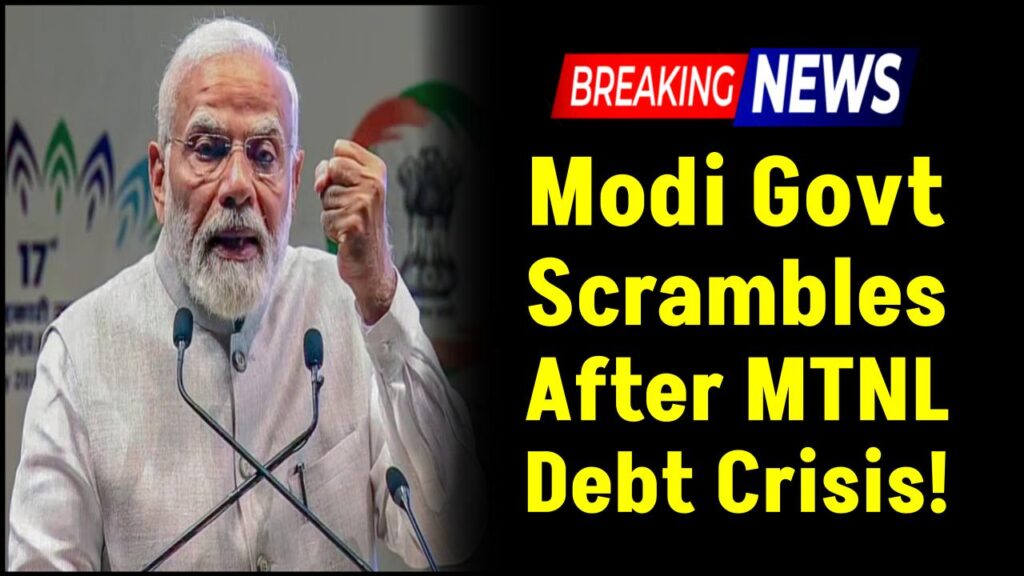Modi Govt Scrambles: Mahanagar Telephone Nigam Ltd (MTNL), a government-run telecom company, has defaulted on a massive loan worth over ₹8,300 crore, sparking a quick and urgent response from the Modi government. The situation has triggered renewed discussions on the health of India’s public sector undertakings (PSUs), the future of privatization, and the sustainability of repeated bailouts. Despite previous financial support and bailouts, MTNL’s inability to meet its loan obligations has raised red flags across financial and administrative circles. As a result, a high-level meeting involving senior government officials and bankers has been scheduled for May 16, 2025, aiming to map out a strategy to manage and possibly contain the growing crisis.

Modi Govt Scrambles
| Topic | Details |
|---|---|
| Defaulted Amount | ₹8,300 crore |
| Government Support | ₹8,000 crore allocated in 2024–25 budget for bond repayments |
| Upcoming Meeting | May 16, 2025 with Cabinet Secretary and bankers |
| Related PSUs in Crisis | Rashtriya Ispat Nigam Ltd, Pawan Hans |
| Privatization Shift | Government leaning toward revival vs aggressive privatization |
| Official Government Source | Economic Times |
The MTNL loan default is more than a financial hiccup. It’s a signal that India needs a smarter, more sustainable strategy for managing public sector enterprises. With a pivot from privatization to revival and reform, the Modi government has shown it’s willing to rethink policy. But unless there is transparency, accountability, and modernization, bailouts alone won’t be enough.
What Happened with MTNL?
MTNL, once a flagship telecom provider in Delhi and Mumbai, has been struggling financially for over a decade. Mounting debts, declining revenues, and rising operational costs have made survival increasingly difficult. On top of prior government assistance, MTNL has now defaulted on more than ₹8,300 crore in loans from public sector banks. This is not a small figure. It’s equivalent to more than the annual budget of some small Indian states. This has triggered alarm bells in both government and financial institutions, as the domino effect could strain the already fragile balance sheets of public sector banks.
Why This Matters for India
When a government-run enterprise defaults on a loan, the implications go beyond the company itself. Here’s why this is important:
Impact on Public Sector Banks
Banks like SBI and PNB, which lent to MTNL, might face increased Non-Performing Assets (NPAs). These NPAs affect their ability to lend further and raise capital.
Burden on the Taxpayer
Government bailouts use taxpayer money, meaning the financial weight is indirectly borne by citizens.
Signaling Trouble in PSU Management
This default showcases long-standing issues in governance, accountability, and transparency in India’s PSU sector.
Government’s Response: What Are They Doing?
The Modi government, known for its push toward privatization, seems to have temporarily shifted course. Here’s a detailed look at their response:
₹8,000 Crore Budget Allocation
In the Union Budget 2024–25, the government set aside ₹8,000 crore to repay bonds issued by MTNL. This isn’t a long-term fix, but it prevents an immediate crisis.
High-Level Meeting on May 16
A meeting chaired by the Cabinet Secretary is scheduled to include public sector bank officials. The agenda: preventing further fallout and exploring structural solutions for MTNL’s debt.
Shift from Privatization to Revival
According to a Reuters report, the Indian government is now considering financial revival packages instead of outright disinvestment.
Wider Implications for Public Sector Enterprises
MTNL is not alone. Several other state-run firms are walking a financial tightrope:
- Rashtriya Ispat Nigam Ltd
- Pawan Hans Helicopters Ltd Together, these companies may receive over $1.5 billion in government aid in the coming fiscal year. The big picture here shows a move toward reviving rather than selling struggling PSUs.
Is This Sustainable? Expert Opinions
While Finance Minister Nirmala Sitharaman claims that over ₹10 lakh crore in bad loans were recovered between 2014 and 2023 (Economic Times), financial analysts remain skeptical. Repeated bailouts may not be fiscally sustainable, especially if the underlying issues in PSU operations aren’t fixed.
A Simple Breakdown: What Needs to Happen Now?
Here’s a step-by-step look at what can help resolve the MTNL crisis:
Step 1: Transparent Financial Review
The government must undertake a complete audit of MTNL’s finances to understand the real extent of the problem.
Step 2: Stakeholder Consultation
A collaborative plan involving banks, the Department of Telecommunications, and financial experts must be created.
Step 3: Technological Modernization
MTNL’s operations and technology must be modernized to stay competitive in today’s digital-first market.
Step 4: Explore Public-Private Partnerships (PPP)
Rather than selling or bailing out, PPP models can bring in private sector efficiency without giving up government control.
FAQs on Modi Govt Scrambles
Why did MTNL default?
Primarily due to decades of financial mismanagement, rising competition from private telecoms, and outdated infrastructure.
Is MTNL going to be privatized?
Currently, the government appears to be moving toward a revival model instead of privatization.
How does this affect the common man?
Taxpayer money is used in bailouts, and reduced bank lending due to NPAs could limit credit availability.
Are other PSUs in trouble too?
Yes. MTNL is one of several PSUs facing significant financial issues. Others include Rashtriya Ispat Nigam Ltd and Pawan Hans.





